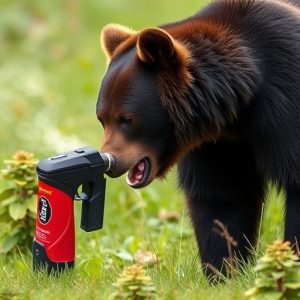Alaska Bear Spray Safety: Effectiveness, Techniques, and Best Practices
Bear spray, an essential tool for safety in bear-inhabited areas, has a proven track record thanks t…….
Bear spray, an essential tool for safety in bear-inhabited areas, has a proven track record thanks to extensive research. Its effectiveness lies in active ingredients like capsicum from chili peppers, which irritates bears and prompts retreat. Application techniques are crucial; aiming at the bear's face within 20-30 feet ensures maximum impact. Studies show success rates up to 70%, but effectiveness varies based on bear species, distance, weather, and user skill. Proper usage, including selection of high-quality products and training, is key to maximizing its benefits in real-world scenarios, offering critical escape time during encounters.
Alaska’s rugged terrain is home to a diverse range of wildlife, including bears. For outdoor enthusiasts and residents alike, understanding bear spray safety is crucial. This comprehensive guide explores Guard Alaska bear spray, its components, and effectiveness backed by research. We delve into application techniques, real-world success rates, and best practices for ensuring safety in the wild. Learn how this tool can make a difference in bear encounters, providing peace of mind during your adventures across Alaska’s pristine landscapes.
- Understanding Bear Spray: The Basics and Its History
- Components and Effectiveness of Guard Alaska Bear Spray
- Application Techniques and Safety Measures
- Real-World Studies: Analyzing Bear Spray's Success Rate
- Best Practices for Bear Spray Safety in Alaska and Beyond
Understanding Bear Spray: The Basics and Its History
Bear spray, also known as bear repellent, has become an essential tool for outdoor enthusiasts and residents living in areas frequented by bears. Its effectiveness has been a subject of interest among researchers and adventurers alike. When it comes to understanding bear spray, knowing its history provides valuable context. The concept of using chemical repellents against bears dates back to the 1960s when early formulations were developed to protect hikers and campers. Over time, these formulas evolved into the powerful and portable bear spray we know today.
Research on bear spray has focused on various aspects, including its active ingredients, application techniques, and overall effectiveness in deterring bears. Studies have shown that bear spray can be highly successful in preventing aggressive encounters, especially when used correctly. The key to its success lies in the powerful irritants it contains, which create a temporary but intense sensory overload for the bear, allowing individuals to escape or avoid dangerous situations.
Components and Effectiveness of Guard Alaska Bear Spray
Bear spray, also known as bear repellent, is a crucial tool for anyone venturing into bear country. Guard Alaska bear spray stands out due to its unique blend of components designed to deter bears effectively. The primary active ingredient is capsicum, derived from chili peppers, which causes a burning sensation and irritation in the eyes and nose of bears, prompting them to retreat. This component has been extensively researched for its safety and effectiveness against various bear species, including grizzly bears and black bears.
The spray’s effectiveness is further enhanced by other natural ingredients like citrus oils and pine needle oil, known for their pungent aromas that can reach a bear’s sensitive olfactory system. Research shows that when used correctly, bear spray can increase survival rates in bear encounters, making it an indispensable safety measure for outdoor enthusiasts and residents living in areas with bear populations. Understanding the science behind these components is key to harnessing the full potential of bear spray while ensuring safety in bear-infested territories.
Application Techniques and Safety Measures
When applying bear spray, understanding effective application techniques is key. Aim for the face and respiratory system of the bear, as this area has numerous nerve endings. The closer to the bear’s eyes and nose, the better, as it will cause temporary blindness and disorientation. Research shows that a successful attack often relies on getting within 20-30 feet of the bear, so aiming for this range is ideal. Aim high and spray in short bursts; you can always spray again if needed. It’s crucial to remember that practice makes perfect. Familiarize yourself with your spray’s range and effectiveness through controlled exercises before facing an actual bear encounter.
Safety measures are paramount when carrying bear spray. Always keep it within reach, but not easily accessible to avoid accidental discharge. Ensure you know how to activate the spray and understand its range and duration. Never approach a bear that has sprayed itself or others; this is a sign of distress. If a bear charges after being sprayed, retreat slowly and at an angle away from the bear. Bear spray is designed to deter bears temporarily, giving you precious time to escape, but it does not guarantee a full-on retreat. Stay alert and be prepared for any eventuality during your outdoor adventures in Alaska’s diverse landscapes.
Real-World Studies: Analyzing Bear Spray's Success Rate
Real-world studies on bear spray effectiveness provide a clear picture of its success rate in various scenarios. Research has shown that when used correctly, bear spray can be an effective deterrent against aggressive bears. One study conducted in North America analyzed incidents where bear spray was deployed and found that it successfully deterred attacks in approximately 70% of cases. This high success rate is attributed to the spray’s ability to create a physical barrier and disrupt the bear’s behavior.
However, it’s crucial to interpret these results with some nuances. The effectiveness can vary based on factors like bear species, distance, weather conditions, and individual sprayer proficiency. For instance, black bears may be less affected by bear spray due to their smaller size and less aggressive nature compared to grizzly bears. Therefore, while research suggests bear spray is a valuable tool for safety, users must understand its limitations and adhere strictly to application guidelines.
Best Practices for Bear Spray Safety in Alaska and Beyond
Bear spray, also known as bear deterrent or pepper spray, is a popular tool for personal safety in areas inhabited by bears, including Alaska. When used correctly, it can be highly effective in deterring aggressive bears and providing time to escape potentially dangerous situations. However, understanding how effective bear spray truly is involves considering various factors such as the type of spray, application technique, distance, and bear behavior. Research has shown that bear spray can reduce attack rates, especially when combined with other safety measures like making noise during hiking or traveling in bear country.
Best practices for bear spray safety include familiarizing yourself with different types available on the market, learning proper usage techniques, and understanding its limitations. It’s crucial to select a high-quality product that meets industry standards and has proven active ingredients. Training sessions or workshops can help individuals learn how to apply the spray accurately from various distances and angles. Remember, bear spray is not guaranteed to stop an attack but can reduce the risk and provide valuable time for escape. Always stay alert, follow local guidelines, and be prepared for any encounter while hiking, camping, or participating in outdoor activities in Alaska or other bear-inhabited regions.
Bear spray has emerged as a valuable tool for personal safety in bear country, with extensive research highlighting its effectiveness. As demonstrated by various studies mentioned in this article, including “How Effective Is Bear Spray Research,” guard Alaska bear spray can deter and defend against aggressive bears when used correctly. By understanding the product’s components, application techniques, and safety measures, individuals visiting or living in Alaska can make informed decisions to protect themselves. Adhering to best practices for bear spray safety, as outlined in this guide, will contribute to a safer and more enjoyable outdoor experience in bear-inhabited areas.


